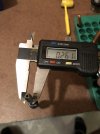dfanonymous
Well-Known Member
- Joined
- Jul 16, 2016
- Messages
- 2,456
.291 is the neck tension I use. But it's after annealing…You guys might want to stop helping me. I'm about to have a fire sale on a bunch of components!
Loaded neck OD .291
I chamfered. Just tried annealing too with no change in virgin brass. I take back the comment about it loading easily on 2x. Tried again. Still hard.
heres a picture of the expander on the Rcbs. It's obviously getting some work.



